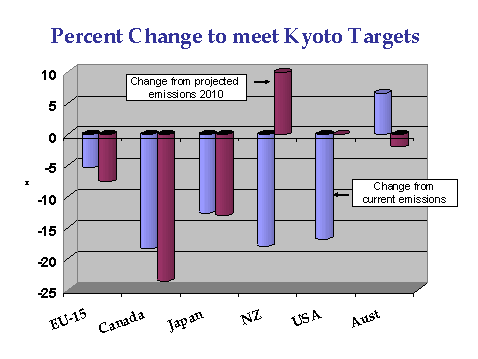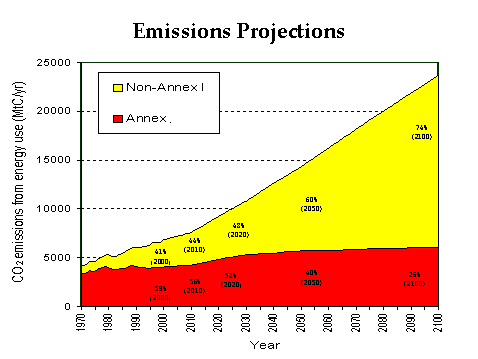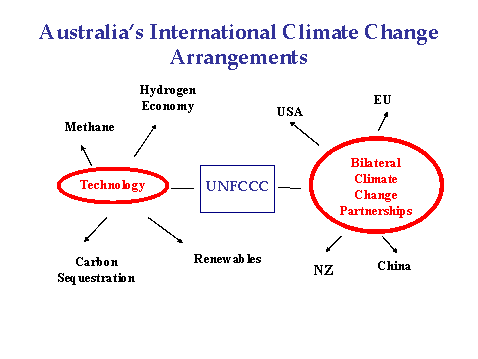Introduction
It gives me great pleasure to speak to you on the international climate change agenda.
As a world-leading research organisation, CSIRO is well-positioned to contribute to the climate change debate both domestically and internationally.
CSIRO's climate change research is highly valued in the policy making arena. As international discussions move forward, CSIRO and similar research organisations will retain an important role in informing policy makers of vital details.
In my comments today I will:
- outline the current state of play in international climate change negotiations
- describe various international initiatives already underway to address climate change, and
- highlight Australia's international and domestic climate change policies.
My comments are more restricted than usual today, given the Government is in caretaker mode.
Current state of play in international climate negotiations
Multilateral climate change negotiations are at a crossroads. While there is reasonably solid consensus on the science, there is as yet no international political consensus on how to address the challenge posed by climate change.
Seven years after finalising the Kyoto Protocol - it is still not in force.
As many of you would know, US or Russian ratification is needed before the Protocol can enter into force.
The US has indicated that it will not ratify Kyoto under any circumstances.
There is less clarity about Russian intentions, although recent developments suggest some prospect of ratification, although timing remains uncertain.
This uncertainty around the Kyoto Protocol's entry into force has caused multilateral climate negotiations under the UN Framework Convention on Climate Change to reach near inertia.
There is no doubt that the Kyoto Protocol represented a good faith effort by the international community to deal with climate change.
There is, however, increasing international recognition that even if Russia does ratify - the Kyoto Protocol will not deliver a comprehensive solution to the problem. ABARE estimates the Protocol will result in negligible reductions in global greenhouse gases.
- Australia is on track to meet its Kyoto target for greenhouse gases, but many of the most enthusiastic advocates of Kyoto - the EU, Canada and Japan - are overshooting their targets at this stage.
[Graph of where each country is tracking on Kyoto targets]
- More importantly, many of the world's major emitters - such as the US, China, India and Brazil - have not committed to emission targets.
- This undermines the environmental effectiveness of the Kyoto Protocol
- This problem will only be amplified in the future as developing country emissions overtake developed country emissions
[Graph of future CO2 projections - Non Annex 1 vs Annex 1]
So, in addition to Australia, major players - including the EU, Japan, the US, many business organisations, think tanks and research institutes - are beginning to look beyond the initial Kyoto period of 2008-2012.
- The "post 2012" environment will be one of themes of the tenth Conference of the Parties to the UN Framework Convention on Climate in December this year.
- The UK is planning to use its position as G8 chair next year to promote renewed international commitment to address climate change, beginning with a scientific meeting in Exeter in February to address issues including:
- "What level of greenhouse gases in the atmosphere is self-evidently too much?" and
- "What options do we have to avoid such levels?"
Whether or not the Kyoto Protocol enters into force, we expect international negotiations on the future international architecture to start to develop pace towards the end of 2005.
Australia is an active participant in this debate, and it will be a prominent issue for the incoming government.
Even so, history tells us that we should not expect quick or easy outcomes to international negotiations on future frameworks. The reality is that they will probably take some time.
In the meantime, one issue on the international climate change agenda that is gathering momentum, particularly from developing countries, is cooperation on adaptation to climate change.
- It is likely to be a major issue at COP10.
The nascent international discussions on adaptation reveal that this is an issue that warrants greater policy and research efforts.
- There is no obvious consensus, for example, on the definition or scope of adaptation for climate change.
International Climate Change Initiatives
While the multilateral negotiations have slowed, there has been an expansion in activity in other configurations.
- Technology initiatives among smaller groups of countries have gained momentum, e.g. on geosequestration.
- Scientific collaboration has helped reduce some uncertainties - although many remain.
- Business interest in the opportunities associated with climate change has expanded.
- Countries have gained experience in implementing domestic climate change measures and are sharing their experience.
- Public awareness has grown.
So, regardless of the future of the Kyoto Protocol, momentum is building and ideas are beginning to emerge from various quarters.
A future international response to climate change may involve a variety of approaches involving multiple players.
- Business will have a central role in innovation and in taking up new technologies - especially in energy, transport and agriculture sectors. Many companies are already looking for solutions - for example, BP is involved in an Algerian project which aims to capture and store 17 million tonnes of CO2.
- Governments will continue to set international and domestic frameworks, provide incentives and support research.
- Research organisations will be critical in advancing scientific and technological options
- The community will also need to be involved by choosing low-emission consumer options.
As one grand, overarching international instrument is unlikely, the overall international response to climate change must necessarily contain a tapestry of initiatives.
In the future, a consolidated international political agreement may follow rather than lead other developments.
Australia's International Approach
Internationally, Australia's objective has been an effective global response engaging all major emitters. [Graph on major emitters]
[Chart mapping international involvements - multilateral, plurilateral and bilateral]
Bilateral climate partnerships
Developing bilateral climate partnerships with the United States, the European Union, New Zealand and China has been important to meeting this objective.
- The value of these partnerships is that they focus on practical collaboration, for example, in September Australia and China held a workshop in Beijing that facilitated cooperation on renewable energy. Businesses from China and Australia were heavily involved, promoting better business links on climate change.
- Some of you would know that CSIRO has been directly involved in these partnerships.
- Indeed, CSIRO researchers attended the Beijing workshop to explore options for future joint projects with Chinese research institutions.
- CSIRO also has concrete projects underway.
- Under the US-Australia partnership CSIRO ocean climate modellers are working with their US colleagues in Geophysics Fluid Dynamics Laboratory (GFDL) to upgrade ocean climate models.
I would encourage CSIRO to continue this close and practical engagement in these bilateral partnerships.
International technology initiatives
Technology is playing a decisive role in meeting the challenge of climate change and its role will become increasingly important.
International engagement in international technology initiatives is crucial for Australia in:
- accessing new technology,
- promoting Australian innovation, and
- influencing the development and acceptance of new technologies to meet Australian priorities.
Australia's international technology collaborations provide promising opportunities for major emissions reductions in the future.
- Like bilateral partnerships, technology collaborations can bridge the divide between developed and developing countries that is often amplified in the UN system.
International technology collaborations also provide promising opportunities for increased CSIRO engagement - both with overseas counterparts and Australian policymakers.
- The substantial contribution that CSIRO is making to the International Partnership on the Hydrogen Economy is an excellent example of CSIRO taking up such opportunities.
There may be scope for CSIRO contribution and engagement in similar initiatives that promote low emission technologies.
- For example, the Renewable Energy and Energy Efficiency Partnership is a coalition of governments, business and civil society that aims to expand the global market for renewable energy and energy efficient technologies.
- Another example is the Carbon Sequestration Leadership Forum - a forum of 17 countries to facilitate the development of cost-effective methods for safe storage and capture of carbon dioxide.
- Australia is also exploring a new US-led initiative on the capture and storage of methane.
In September Australia hosted the second Ministerial meeting of the Carbon Sequestration Leadership Forum here in Melbourne. Ministers agreed on a roadmap to progress the Forum's aims of cooperative research and development for the separation, capture, transportation and storage of carbon dioxide.
Australia is also engaged in bilateral energy arrangements with key trading partners, including Japan, Korea, China, Taiwan, the United States, Indonesia and India, which include technology collaboration elements.
Australia is also an active participant in the APEC Energy Working Group that facilitates energy technology development, exchange, application and deployment.
As many of you will know, Australia is a party to fifteen International Energy Agency implementing agreements
- enabling experts from different countries to work collectively, share the cost of research, and pool scientific and technical results.
- Of course, CSIRO leads Australia's engagement on agreements, including Clean Coal Gas Sciences and Fossil Fuel Multi-Phase Flow Sciences.
Engagement in these international forums help Australian policy makers stay ahead of the game - or at least keep up with it!
Over the next year or so, it will be important to ensure the information from these networks is available and flowing through to negotiators.
Domestic Action
Managing climate change risks is a challenge for all countries.
None of us can do it alone - certainly not relatively small emitters like Australia.
But action at the domestic level can help to build the confidence among parties necessary to underpin effective action at the global level.
Domestically, Australia has committed nearly $1.7 billion in climate change measures across the economy, including the energy, transport and agricultural sectors.
As in the international sphere, technology is a focus for domestic climate change action.
Targeted investments have already been made to develop the technologies that will deliver a vibrant economy with a lower greenhouse signature.
- The CSIRO flagship program "Energy Transformed" is an excellent example.
Technology improvements will be a key to delivering large-scale reductions in emissions in a way that protects and promotes Australia's long-term economic prosperity.
Indeed, Australia could meet a large part of its energy needs today through low or zero emissions sources of energy.
- In an article recently published in Science, Princeton University researchers Pacala and Socolow found that scientific, technical and industrial knowledge already exists for 15 alternative technology options to stabilise global warming.
- They found that, in combination, these 15 options had the potential to meet the world's energy needs over next 50 years and substantially limit emissions.
- While these studies are encouraging, the researchers did not examine the costs of scaling up or implementing each of the technology options.
The current Government's strategy for technology has been to try and fill this gap by increasing the range of options and lowering the cost of meeting future greenhouse objectives through
- Developing a wider range of lower-cost low-emission technologies with special attention to develop coal and gas-based technologies to preserve the value of our resource exports.
- Facilitating the transition to low-emissions energy sources
- including support for new technology uptake as well as implementing appropriate regulatory and market frameworks that do not discriminate against new technologies.
Energy White Paper
The Energy White Paper provides the most recent policy context for Australia's current climate change approach. The Paper outlines policies to reduce greenhouse emissions while enhancing energy security, and recommends aggressively developing low emission technologies, such as carbon sequestration and clean coal, and promoting energy efficiency and renewable energy.
The Energy White Paper focuses on reducing the costs of development and deployment of technology and includes:
- establishing a $500 million fund to support industry-led demonstration projects of technologies, and a further $100 million to support development of smaller-scale renewable technologies.
- commencing Solar Cities trials to model of how solar technologies, energy efficiency and efficient markets can combine; these trials will address current lack of rewards for the unique characteristics of photovoltaics, and market barriers to energy efficiency.
- facilitating commercially attractive emissions reductions, including through mandatory energy efficiency opportunity assessments, and an enhanced Greenhouse Challenge programme.
- Supporting renewables by continuing the MRET.
Conclusion
In highlighting the different initiatives being pursued domestically and internationally, I have tried to paint a picture of a plethora of promising - if decentralised - efforts to address climate change.
A comprehensive international agreement on climate change - a subject of such complexity and uncertainty - remains a major challenge and one that still appears a longer term prospect.
This does not discount the value of international collaboration - being an inherently global problem, climate change requires a global solution.
Whatever form climate change solutions take, Australia's fundamental objective is to ensure that understanding of the threat posed by climate change and policy responses are based upon sound analysis and sound science.
CSIRO clearly has a major contribution to make in meeting this objective.
I hope CSIRO continues to play an active role both the international and domestic climate change agenda - and that our agencies continue to cooperate closely.
I hope my remarks will assist your consideration of the future directions for CSIRO Climate.



